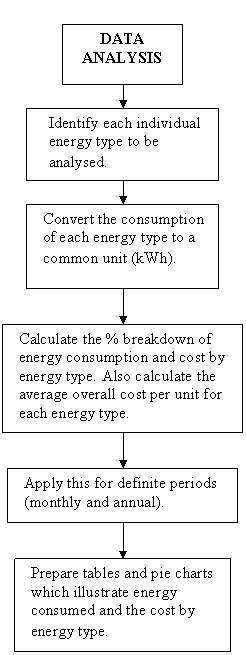


Methodology for Determining the Energy Demand
The method for determining energy demand in rural locations can be broken down into three constituent parts: Data Collection, Data Estimation and Data analysis. We have developed a series of flowcharts for determining and collating the energy demand; from which a better understanding of the energy usage can be obtained. The flowcharts are primarily based on CIBSE preliminary audits.
Data AnalysisFigure 1. Data Analysis Flowchart
Data Analysis allows for the comparison of energy use by amount and cost. Comparing the energy consumed and the cost by energy type gives a useful economic analysis and shows where the largest savings can be made.
The common unit we have chosen to use is kWh. All answers in Watts should be converted to kWh.
The breakdown of energy use for definite periods is particularly necessary for renewable energy systems as the intermittency of supply dependent on climatic conditions must be matched with seasonal energy demands.
Energy Demand References:
- CIBSE Applications Manual: Energy Audits and Surveys. AM5: 1991. CIBSE.
- McMullan Randall. Environmental Science in Building: 6th Edition. 2007.
- ASHRAE Fundamentals Handbook: IP Edition. 1989. ASHRAE.
- Planning and Installing Solar Thermal Systems: A Guide for Installers, Architects and Engineers.
DGS (The German Solar Energy Society), Ecofys. 2005.
- http://www.energysavers.gov/your_home/appliances/index.cfm/mytopic=10040
- Energy Demand and System Sizing. No. 2 in Series “Studies in Energy Efficiency in Buildings”.
British Gas. 1980.
- Fowler Kenneth. Design of Thermal Loads for Building Structures. Practical Building Services
Design. Vol. 2.1985.
- Moss J. Keith. Energy Management in Buildings. 2nd Edition. 2006.
| MSc: Renewable Energy Systems and the Environment | © University of Strathclyde 2010 |
